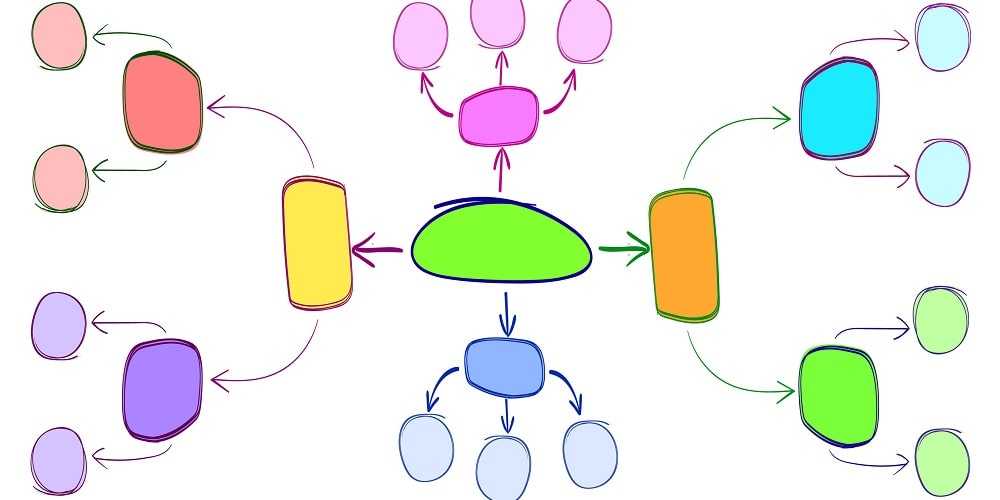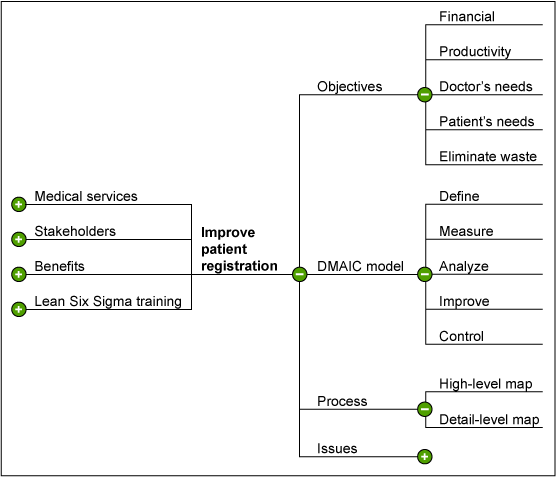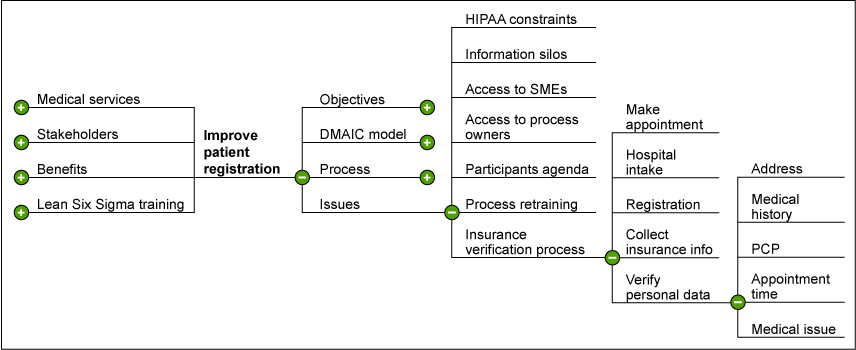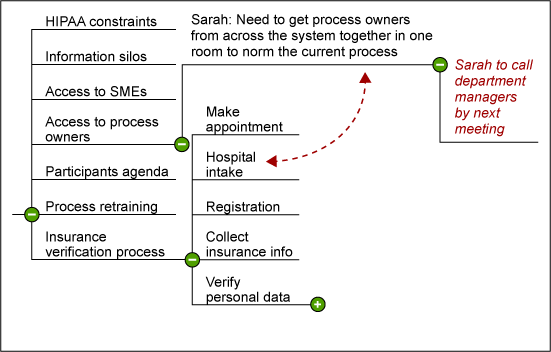
Hospitals and health plans know that the high cost of care is squeezing the U.S. economy. That’s why so many of them are using Lean Six Sigma to control spending by refining internal processes – while still satisfying customers in a highly competitive market.
A major health care consortium based in the Dallas-Fort Worth area used Lean Six Sigma to find ways to improve its health insurance validation process and thereby improve customer satisfaction. With a looming deadline before them, Ralph Jarvis, principle of Jarvis Business Solutions, and his staff used mind mapping to kick off and manage a Lean implementation that resulted in a dozen ways for the hospital to improve its insurance validation process.
Mind mapping software uses visual shorthand to capture in one screen the kind of complexity and depth that might otherwise take many pages of text to represent. It does this by: encouraging the use of keywords and phrases, rather than full sentences; providing a library of icons that can be used to express graphically what otherwise requires words; and enabling users to place each piece of data into spatial context with related pieces.
As a result of this technique, the healthcare consortium team came up with a dozen ways to improve the company’s insurance validation process, which, when fully tested, is slated to be rolled out to 11 affiliated hospitals across Texas.
“The goal was to improve the patient experience by reducing wait times,” Jarvis said. “By improving the way it captured and reused information, the hospital could reduce the amount of paperwork needed to move patients within and between hospitals in the consortium.”
What’s the Problem?
Jarvis’s Lean team decided early on to use the DMAIC (Define, Measure, Analyze, Improve, Control) methodology. Critical to DMAIC is the ability to gain a clear understanding of the voice of the client. Experience has taught Jarvis that while the client may have already identified a main problem, it often turns out that the real problem is somewhere else. Part of the Lean team’s job was to combine the DMAIC roadmap with empirical data to identify and then solve the real problem behind the validation process.
Jarvis and his team held initial brainstorming sessions with key hospital stakeholders. The goal was to gather ideas and insights that would help identify potential trouble spots. Jarvis knew that one of the best ways to manage the kind of divergent-to-convergent thinking typical of brainstorming was to use mind mapping.
As can be seen in Figure 1, mind maps capture information in a format that resembles the top-down view of a tree, with a central core, main branches that reach out from the center, and then branches that get smaller (sub-branches) and smaller (sub-sub-branches) the further out you go from the trunk.

Using this visual metaphor to capture their thinking, the team discovered that what they thought was one problem was, in fact, three separate but connected problems: One customer-focused, one focused on the hospital and the doctors, and the third focused on insurance.
A Better Way to Take Notes
For each problem they created a project team. Each team included from 15 to 20 participants, from senior executives to the data entry clerks. And each team used mind mapping to keep track of their progress.
Mind mapping made note-taking a central byproduct of their meeting process. One person on each team was responsible for creating the notes. Unlike most note-taking methodologies, however, mind mapping enables that person to be an active participant in the meeting. Projected on a wall or screen, mind maps gave each team instant feedback on its thinking process and:
- Created very accurate notes, with team members correcting errors or omissions as the notes are created.
- Kept teams focused and on track, their thinking displayed clearly before them.
- Turned into agendas for subsequent meetings, complete with assigned tasks and due dates.
- Provided a concise, content-dense way to archive team thinking.
However, the term “note taking” falls far short of describing the true power of mind mapping. Unlike typically static meeting notes, mind maps are alive and dynamic. As time passed and team members continually refined their thinking, they added new thoughts to the map and revised old ones.
Putting Meat on the Bones
Now that each teams had identified its respective problem, the next step was to add relevant data. The DMAIC roadmap is a data-driven process. That is why, as part of the DMAIC process, participants must agree at the beginning of the process to provide needed data. In a sustained environment, stakeholders from, say, accounting, IT and process owners would capture that information through system usage. But in this case, the data wasn’t immediately accessible.
One data set the hospital teams needed was a clear understanding of the current registration process (see Figure 2). First they mapped out the process itself: Someone has an appointment to see a doctor, they come in to the hospital, they register and their insurance information is taken down – as is their address, medical history, doctor, appointment time and reason for seeking medical care.

The team set about linking the maps to new information and data in the form of reports, spreadsheets, slide shows and websites. The mind maps’ drag-and-drop functionality enabled them to place supporting data immediately adjacent to the relevant insight or idea.
The team also used mind maps to analyze internal data – the information that is created when individuals are able to react to external data and interpret the data based on insight born from intimate familiarity with the subject. This juxtaposition of information and previous experience is where some of the best thinking and planning can take place.
Rather than being seen as isolated items or bullets frozen into a list, mind maps treat each piece of data, each idea, as pieces of a jigsaw puzzle that can be moved around at will to find the place where they fit best (see Figure 3). This kind of flexibility invariably sparked creativity as team members could see, understand and build on each other’s thinking.

“The fun part about any kind of consulting,” Jarvis said, “is when you get to brainstorm with the client, to extract information regarding the issues, regarding the problem. This is an opportunity to tap in on the creative side of your clients. Once analyzed, this information can lay the foundation for a successful project.”
From Bird’s Eye to Worm’s Eye
Analysis of this much information and ideas requires a degree of dexterity that traditional office tools are hard pressed to manage. Mind mapping uses visual shorthand to capture in one screen the kind of complexity and depth that might otherwise take 10 or 20 pages of text to represent. It does this by encouraging the use of key words and phrases, rather than full sentences; by providing a library of icons that can be used to express graphically what otherwise requires words; and by enabling users to place each piece of data into spatial context with related pieces.
This much information on one screen could be overwhelming. But another advantage of mind mapping over traditional business documents is the ability to selectively hide information. Mind map branches can, with the click of a button, collapse to reduce clutter on the screen and focus attention on a small part of the map.
Conversely, the branches also can be expanded to enable users to drill down to as much detail as they have stored in the map. By clicking on the “+” signs on the map, users can reveal additional information. That information can range from a quick thought jotted down on the fly, to entire reports, relevant emails or information typed into a “notes” field associated with that branch. The chain links icon above indicates that additional documents or websites are hyperlinked to the branch.
The end result is an easy-to-manipulate, content-dense and yet easily navigated kind of information object – a single document that gives users intuitive access to a vast amount and variety of information – all in one location.
With its initial analysis completed, the team then switched from mind mapping to project management to start optimizing the current validation process. Jarvis used a mind mapping software suite that included both mind mapping and project management capabilities to help them through this phase of the project.
Once Jarvis and his team implemented a number of control systems to monitor the reconfigured insurance validation process, mind mapping again served a key role as a concise visual overview of the new process – an information object to which new notes, screen shots, user input and data could be added. In keeping with the final DMAIC stage of controlling the future state process, this single view helped ensure that the hospital could create a record of process imperfections and how they were corrected to keep the new process flowing smoothly.
Mind mapping’s ability to transform unstructured brainstorming into a highly structured project plan enabled Jarvis’ team to move quickly while still keeping its eyes on the main objectives established at the beginning of the project. The combined power of mind mapping plus project management supported his team through the entire project lifecycle, he said, and made it possible for the group to provide hospital management with 12 critical recommendations for its customer satisfaction improvement.
Adding to the Lean Six Sigma Toolbox
“What you’re really trying to do with Six Sigma is to create a process that eliminates defects – all the things that don’t add value to the end customer,” Jarvis said. “You want to increase the customer’s satisfaction with your products or services, and reduce costs associated with defects and inefficiencies. It’s all about focusing on what you need to get to the marketplace and satisfy the customer’s needs.”
Jarvis’ statement fits into a concise paragraph, but the process of following DMAIC from initial brainstorming through problem definition, data aggregation and measurement, process improvement and finally control of the future process can be quite complex. Mind mapping is just one of the many tools that seasoned managers like Jarvis can implement with DMAIC to help streamline and simplify complexity.
Editor’s note: Ralph Jarvis’s management guide, Any Questions?, serves as a primer to owners and executives interested in transforming their businesses based on principles that address sustainability and Lean Six Sigma.